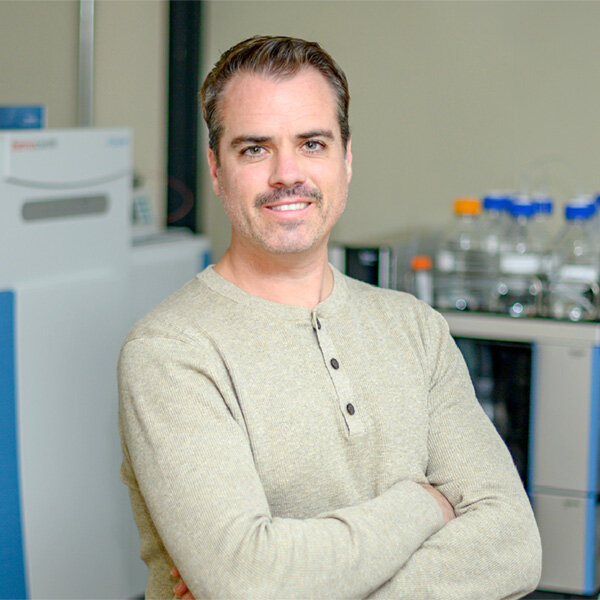Ask someone what they think of when they hear the phrase “bile acids,” and you might get a few unpleasant answers.
Ask Robert Quinn, assistant professor in Michigan State University’s Department of Biochemistry and Molecular Biology housed in the College of Natural Science, and you’ll kickstart a conversation about some of the most versatile and crucial actors in the human gut.
Bile acids are linked to our full-body health, can act as drugs and are some of the best studied molecules in the history of biochemistry.
Now, thanks to a bit of serendipity and a cooperative spirit, Quinn and his lab helped uncover a previously unknown way that the microbes living in our gut help make these important molecules.
After realizing the lab of Andrew Patterson at Pennsylvania State University had similar findings as the MSU researchers, the two teams published separate but complementary papers in the prestigious journal Nature.
Together, the papers reveal surprising contributions from a well-known microbial enzyme.
Secrets of the microbiome
Produced in the liver and stored in the gallbladder, bile acids are some of the most abundant molecules in our guts.
“They act as detergents, not unlike soap,” Quinn explained. “So, when you’re having your nacho cheese while watching the game, they’ll solubilize those fats and help you absorb them.”
For decades, it was understood that our livers conjugate bile acids before releasing them. That means that enzymes in liver cells would add the amino acids glycine or taurine to help the bile acids best do their jobs. These glycine and taurine bile acids have been studied as far back as the 1850s and are crucial to our gut health.
But, in a 2020 paper, Quinn and his colleague showed that microbes could also conjugate bile acids by adding a host of amino acids beyond glycine and taurine.
This discovery was a springboard for deeper exploration.
Spearheaded by Guzior, who studies in MSU’s Department of Microbiology, Genetics and Immunology, the Quinn lab turned its attention to an enzyme known as bile salt hydrolase, or BSH.
BSH is one of the most ubiquitous and well-studied enzymes in the gut microbiome and its traditionally understood role was in breaking down, or deconjugating, bile acids.
To their surprise, the MSU researchers found that the bile acids they discovered in 2020 were actually made by the BSH enzyme.
The discovery showed the enzyme could essentially act in reverse, producing myriad microbially conjugated bile acids that greatly increases the diversity of bile acids — and what they do.
“Different bacteria have different properties when it comes to this reverse activity, and this can very much modify the function of the bile acids,” Quinn said.
The finding also demonstrated that bacteria were capable of making the same bile acids that were once believed to be the exclusive products of human cells.
“It’s a sort of molecular mimicry that challenges scientific dogmas,” Guzior said.
“For instance, if we detect a change in conjugated bile acid profiles, is that on the side of the host — say, from a liver abnormality — or is it on the side of the bacteria?”
A scientific ‘Land-Grant Trophy’
In a testament to institutional teamwork and scientific community, MSU’s paper appears alongside a second bile acid publication authored by Patterson. The shared discovery and dual publications are like an academic Land-Grant Trophy — the trophy given at the annual meeting of the MSU and Penn State football teams — only here, both teams won. It was a success sparked by a mutual connection and good timing.
When Quinn realized what his team had found, he reached out to his former postdoc adviser, Professor Pieter Dorrestein of the University of California, San Diego. Dorrestein had a surprising reply. He had received similar news from the Patterson lab that same day.
Rather than compete to publish, the MSU and Penn State groups instead connected and worked together to produce two nearly mirrored discoveries.
“The data was almost backwards,” Quinn said. “While we showed the enzyme produced these molecules, the Patterson lab discovered the enzyme and chose to inhibit it, showing that the molecules went away. It was perfectly complementary.”
“A big thanks goes to Pieter Dorrestein at UCSD for bringing us all together,” said Patterson.
“We all delved into understanding this new role for BSH, and tackling it together made the experience incredibly rewarding, especially for our highly talented grad students from PSU and MSU.”
The Quinn lab also benefited from regional collaboration with Michigan health experts.
Stewart Graham, director of metabolomics research and director of Alzheimer’s disease research at Corewell Health, provided the MSU researchers with pre- and post-bariatric surgery fecal samples.
Molecular analysis revealed a reduced presence of microbially conjugated bile acids after surgery, showing that these bile acids were altered after changes to gut physiology.
“The findings of this study underscore the age-old adage that ‘it takes a village,’” said Graham. “These results provoke critical questions.”
For Guzior, working with these collaborators has been a highlight of the research experience.
“To have these otherwise unfamiliar labs connect, and to have a free-flowing discussion of ideas as we worked on simultaneous discoveries — the result has been one cohesive story.”
The first steps
No matter the on-field results in East Lansing or State College, researchers at MSU and Penn State are excited to see their dual papers embody the power of scientific collaboration between iconic institutions, and how this work has opened a new era in bile acid research.
“The number of people who are now studying these molecules and engaging in the microbiome and bile acid field is immense,” offered Quinn, who further noted that if individuals could be provided probiotic microbes known to produce bile acids with beneficial properties, they’d make excellent drugs.
Looking ahead, Guzior is confident in what the future has in store for bile acid studies and where these latest discoveries will lead next.
“I’d say we’re on the third step of a staircase that goes all the way to the 10th floor,” Guzior said.
“The possibilities are innumerable.”


